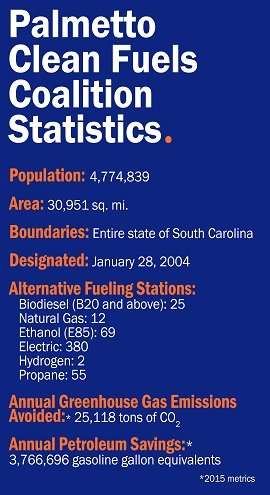by Sharon Purvis

Ten at the Top recently hosted an event called “A Cleaner Future: A Look at Air Quality, Sustainability, and Energy Innovation in the Upstate,” which covered topics ranging from health issues to homebuilding to transporting groceries more sustainably.
In the focus area of transportation, Maeve Mason and Landon Masters from the SC Office of Regulatory Staff Energy Office gave a presentation about their organization’s Transportation Fuel Action Tool—and if you’re scratching your head, wondering why the Energy Office is talking about transportation, Masters offers this statistic in answer: 29% of energy consumption in South Carolina is due to transportation (compared to 32% industrial use and only 22% residential).
With that in mind, the Energy Office has a suite of tools and initiatives aimed at making that consumption more efficient—among them, the above-mentioned Transportation Fuel Action Tool, which helps companies and organizations that own fleets of vehicles to audit and analyze their fleet, factoring in intangibles such as public opinion, political will, economic development, and more, in order to inform decisions about a possible move to alternative fuel sources. Masters notes that in areas where electricity is generated by coal, making a shift to electric vehicles may not be much of a gain in terms of clean energy, but the tool takes that into consideration based on the user’s region.
In partnership with the U.S. Department of Energy, there are also a variety of tools for individuals to make informed decisions about their fuel consumption, whether they’re buying a new or used car, wanting to find alternative fueling stations, or looking for information to read up on the subject. There are mobile tools as well for locating fueling stations and comparing fuel efficiency, emissions, and costs among different vehicles.
 As part of the Palmetto Clean Fuels coalition (PCF), Plug In SC is an initiative whose aim is to increase the adoption of electric vehicles (EVs) by making charging stations visible and easy to find, using signage, pavement markings, and designated parking spaces. It wasn’t enough to simply provide the charging stations, Masters says, because many times they were tucked away behind a concrete wall in a corner of a parking garage. True, EV drivers will find them because they need them, but part of making them visible is creating awareness in other drivers that charging stations are plentiful and accessible.
As part of the Palmetto Clean Fuels coalition (PCF), Plug In SC is an initiative whose aim is to increase the adoption of electric vehicles (EVs) by making charging stations visible and easy to find, using signage, pavement markings, and designated parking spaces. It wasn’t enough to simply provide the charging stations, Masters says, because many times they were tucked away behind a concrete wall in a corner of a parking garage. True, EV drivers will find them because they need them, but part of making them visible is creating awareness in other drivers that charging stations are plentiful and accessible.
A comprehensive state energy plan is in the works—a collaboration of stakeholders putting together a vision for the future of energy in the state and recommendations about what is needed to get there. One of those recommendations came from the transportation subcommittee: Lead by example, particularly when it comes to the adoption of alternative fuel sources and modes of transportation.
“We’ve been working with our stakeholder groups and state fleets to identify goals for adoption of alternative fuel vehicles statewide from a public fleet perspective,” Masters says. “We’re hoping that we can include a recommendation for a state goal, and that goal can be established and we can work using the tool that we have to help fleets make that transition.”
For more information about how your organization or you as an individual can conserve fuel, consider alternatives, and make an impact on South Carolina’s air quality, visit Palmetto Clean Fuels.org.
